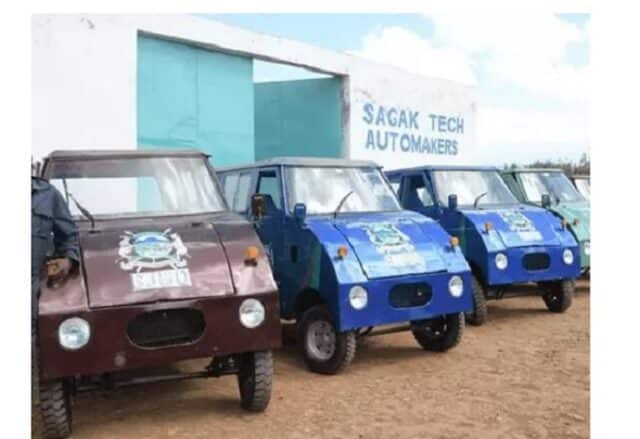
In 2019, the Kenyan car industry experienced a wave of excitement with the release of the Laikipia BJ-50, a locally manufactured car that had the nation buzzing.
However, fast forward to today, and these once highly-coveted vehicles have sadly been forgotten, left to gather dust in Nyahururu’s main garage.
The Laikipia BJ-50 was hailed as a game-changer in Kenya’s automotive landscape, offering an affordable and reliable option for car buyers. With its unique design, fuel efficiency, and impressive features, it captured the hearts of many. But somewhere along the way, these Kenyan-made cars lost their momentum and fell out of favor.
What led to this downfall? Were there issues with production or marketing? The answers remain unclear. However, the fact that these cars now sit abandoned in a garage raises questions about the fate of the Laikipia BJ-50 and the potential missed opportunity for Kenya’s automotive industry.
The rise of the Laikipia BJ-50 cars in Kenya
The BJ50 made its debut in Kenya in 2019, marking a significant milestone in the country’s automotive history.
With the government’s push for local manufacturing and the growing demand for affordable transport solutions, the Laikipia BJ-50 was positioned as a beacon of hope for both car buyers and local manufacturers alike.
The vehicle’s introduction came at a time when Kenyans were eager for alternatives to imported cars, which often came with hefty price tags and maintenance challenges. The BJ50 promised not only affordability but also a sense of national pride, being a product of local ingenuity.
As excitement built around the Laikipia BJ-50, its marketing campaign resonated deeply with the Kenyan populace. The narrative was not just about a car; it was about empowerment, self-reliance, and the potential for local talent to thrive.
The BJ50’s launch events were well-attended, featuring local celebrities and influencers who showcased the car’s attributes. Early adopters praised its combination of unique look and fuel efficiency, which made it an attractive option for both families and businesses. The BJ50 quickly gained interest among various demographics, from young professionals seeking their first car to businesses looking for reliable utility vehicles.
However, the rise of the BJ-50 was not merely a product of effective marketing; it was also a testament to the capabilities of Kenyan engineers and designers. The vehicle was developed with input from local automotive experts, ensuring it met the specific needs of the Kenyan market. As a result, it was hailed as a symbol of what Kenyan manufacturing could achieve when given the right support and resources.
Kenya To Mass Produce Laikipia BJ-50 Cars For International Market
Challenges faced by the BJ-50 cars in the market
Despite its promising start, the BJ50 faced a myriad of challenges that ultimately hindered its sustained success in the market. One of the most significant issues was the initial production scale. While the BJ50 was designed to be affordable, the costs associated with local manufacturing, including labor and materials, often made it difficult to compete with cheaper imported alternatives. As consumers became more price-sensitive, especially amidst economic fluctuations, the BJ50 struggled to maintain its market share against the tide of low-cost foreign vehicles.
The current state of the BJ50 cars in Nyahururu’s main garage
Fast forward to the present, and the once-promising BJ50 cars now lay abandoned in Nyahururu’s main garage, gathering dust and rust. The sight of these idle vehicles serves as a poignant reminder of the fleeting nature of success in the automotive industry. What was once a symbol of national pride and innovation has devolved into a storage facility for forgotten dreams. The garage, once a hub of activity and excitement during the BJ50’s launch, now stands silent, echoing the lost potential of what could have been.
Reports indicate that the cars in the garage are not merely unsold inventory; many are also in various states of disrepair. Issues such as flat tires, dead batteries, and neglected interiors are common among the abandoned BJ50s. This deterioration raises concerns about the viability of reviving these vehicles. Potential restoration efforts would require significant investment, not only to repair the cars but also to re-establish the brand’s presence in a competitive market that has since evolved.
The situation in Nyahururu’s garage has sparked discussions among industry stakeholders about the future of local car manufacturing in Kenya. Some view the BJ50’s decline as a cautionary tale, while others see it as an opportunity to learn valuable lessons. The fate of the BJ50 raises critical questions about the sustainability of local automotive production and the need for a more strategic approach to marketing, production, and after-sales support. As the dust settles on the BJ50 saga, the industry must grapple with the implications of this decline for the future of Kenyan-made cars.
The future outlook for the BJ50 cars
The future of the BJ50 remains uncertain, yet there are glimmers of optimism amidst the challenges. For a successful revival, it will be crucial to address the lessons learned from its initial launch. This includes focusing on building a strong after-sales support network, enhancing marketing strategies, and continuously innovating the vehicle to keep up with changing consumer preferences. If the BJ50 can successfully navigate these hurdles, it has the potential to reclaim its place in the hearts of Kenyan consumers.
Another important aspect of the BJ50’s future is the growing trend towards electric vehicles (EVs) and sustainability. As the world shifts towards greener alternatives, the BJ50 could pivot to embrace electric or hybrid technology. This transition would not only align with global automotive trends but also position the BJ50 as a forward-thinking option for environmentally conscious consumers. By investing in research and development, local manufacturers can create a vehicle that meets modern standards while retaining its local identity.
Ultimately, the future of the BJ50 will depend on the collective efforts of various stakeholders, including manufacturers, government bodies, and consumers. A renewed focus on collaboration and innovation could pave the way for a resurgence in local automotive production in Kenya. The BJ50, if revived successfully, could serve as a cornerstone for a thriving automotive industry that not only meets local demand but also positions Kenya as a competitive player in the regional market.
Conclusion: The legacy of the BJ50 cars
As we reflect on the journey of the BJ50, it becomes evident that its legacy is multifaceted. While the car may have created a swift interest and an equally rapid decline, it has left an indelible mark on the Kenyan automotive landscape. The BJ50 served as a catalyst for discussions about local manufacturing, consumer preferences, and the challenges of competing in a globalized market. Its story is one of ambition, innovation, and the harsh realities that often accompany new ventures.
Despite its current state of neglect, the BJ50 embodies the potential of Kenyan ingenuity. The conversations surrounding its revival highlight a growing recognition of the importance of supporting local industries and fostering a culture of innovation. The lessons learned from the BJ50’s journey can serve as a blueprint for future endeavors in the automotive sector, emphasizing the need for strategic planning, consumer engagement, and a commitment to quality.
In conclusion, the Laikipia BJ-50 may have faded from the spotlight, but its legacy continues to inspire. As stakeholders consider the future of local automotive production, the BJ50’s story serves as a reminder that with resilience, collaboration, and a willingness to learn from the past, the dream of a thriving automotive industry in Kenya is still within reach. The future may hold new possibilities for the BJ50, and with the right approach, it could once again become a symbol of national pride and innovation in the automotive world.
About the Author
Isaac Mbugua is a Senior Journalist and Digital News Writer at Diaspora Messenger News Media







